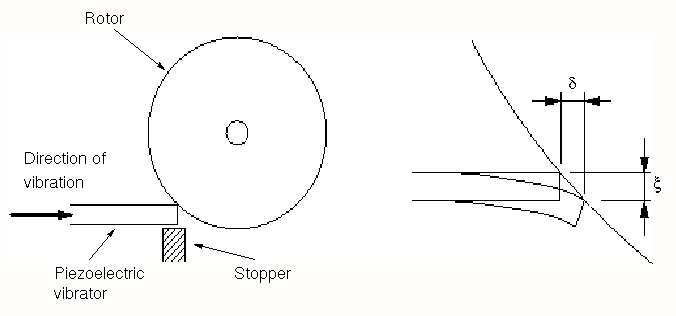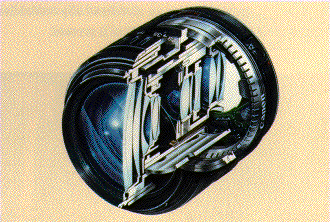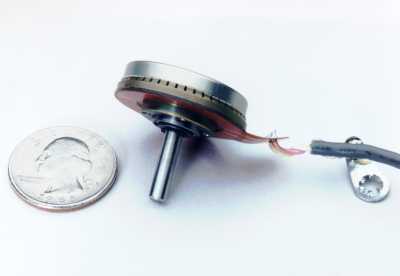Ultrasonic Motors
Ultrasonic motors and linear motors work above 20 kHz and are therefore inaudible to the human ear.
 The above figure illustrates the working principle of an ultrasonic motor. It can be seen that the rotor's movement is caused by the excitation of the piezoelectric vibrator. When the vibrator is excited in the longitudinal direction at high speed, it collides with the rotor's surface as it expands and travels a distance delta. At the same time, the tip is displaced in the transverse direction by a distance xi causing the rotor to move a distance at its surface.
The above figure illustrates the working principle of an ultrasonic motor. It can be seen that the rotor's movement is caused by the excitation of the piezoelectric vibrator. When the vibrator is excited in the longitudinal direction at high speed, it collides with the rotor's surface as it expands and travels a distance delta. At the same time, the tip is displaced in the transverse direction by a distance xi causing the rotor to move a distance at its surface.
The problem with the described motor is that sliding along the surface of the rotor causes great frictional heat loss and hence wear of the piezoelectric vibrator.
Sashida developed an ultrasonic motor by using the above principle but with improved design features, which enabled him to achieve speeds up to 3000 rev/min. The main drawback of this motor is the rapid wear caused by friction at the contact surface between the vibrator and the rotor.
 Another type of ultrasonic motor is the travelling-wave motor. The following figure shows the interior of a ring-type travelling-wave ultrasonic motor.
Another type of ultrasonic motor is the travelling-wave motor. The following figure shows the interior of a ring-type travelling-wave ultrasonic motor.
A small gap between the piezoelectric ceramic and the rotor ring enables the piezo element to extend and collide with the rotor ring when a voltage is applied.
The working principle is based on a travelling wave as the driving signal. The wave drives the comb of the piezoelectric ring. When applied, the piezoelectric combs extend/contract corresponding to the travelling waveform and the rotor ring which is pressed against these combs starts rotating. This phenomenon is rather complex and involves an extensive understanding of the different types of travelling waves.


As illustrated above, one of the most significant applications for travelling-wave ultrasonic motors is in cameras, as an autofocusing mechanism. This started around 1982 in Japan and since then, travelling-wave ultrasonic motors have been studied intensively.
Their main features are that they are quiet and very compact in size, therefore they are ideal for applications in cameras. Although the rotor moves only a micrometer in an individual cycle of the elliptical motion, this can add up to a speed of 2cm/sec at 20 kHz. Further features of the comb teeth is to amplify vibrations. The grooves also allow the dust created by friction to escape and so keep the contact surface dust-free.
[
Main
| About me
]
Last updated on the 16th of June, 1998
T.Hack - th206@eng.cam.ac.uk


